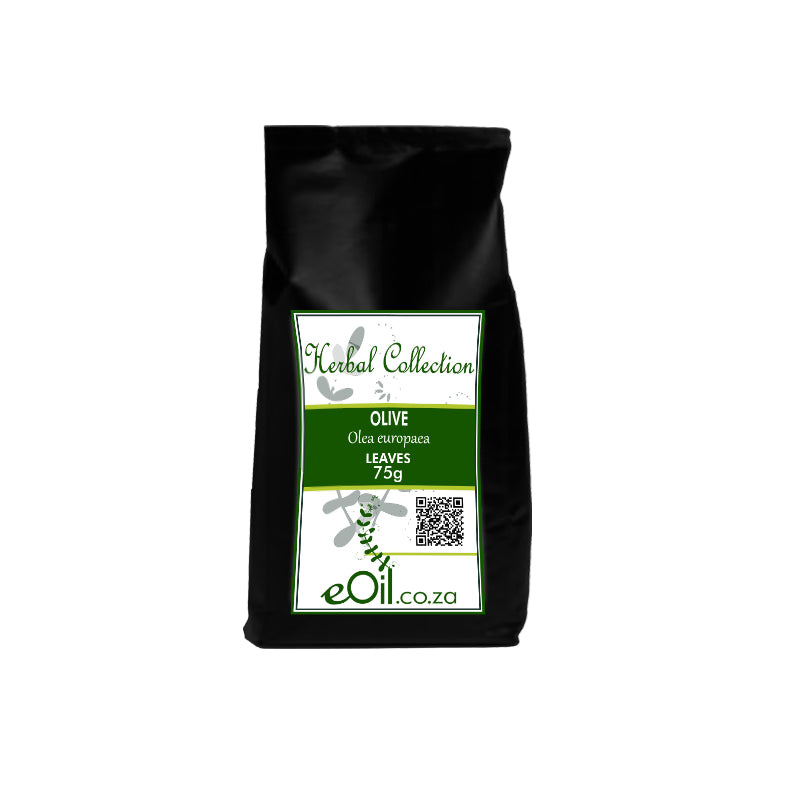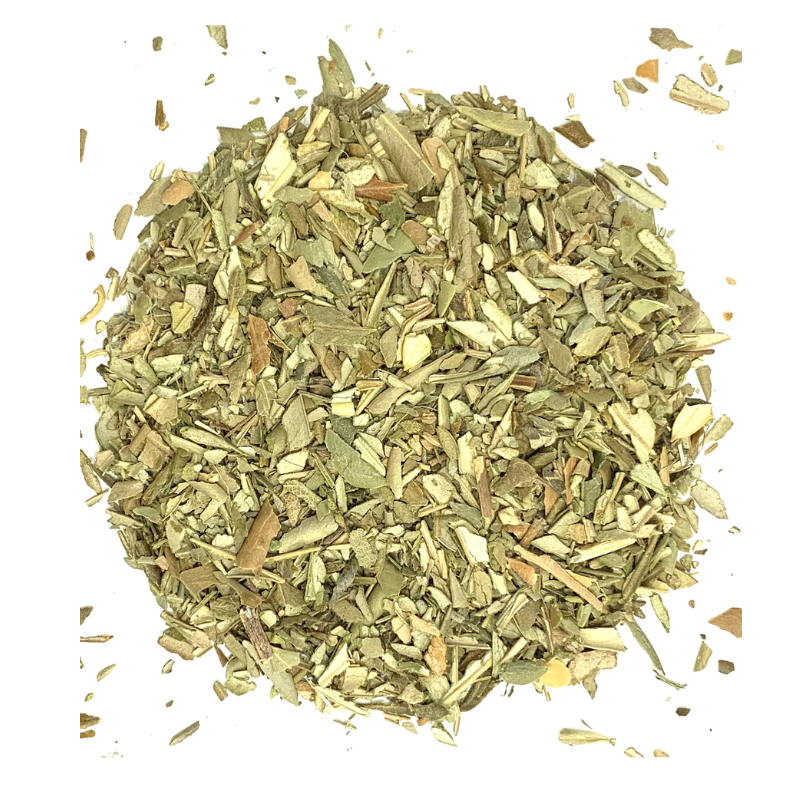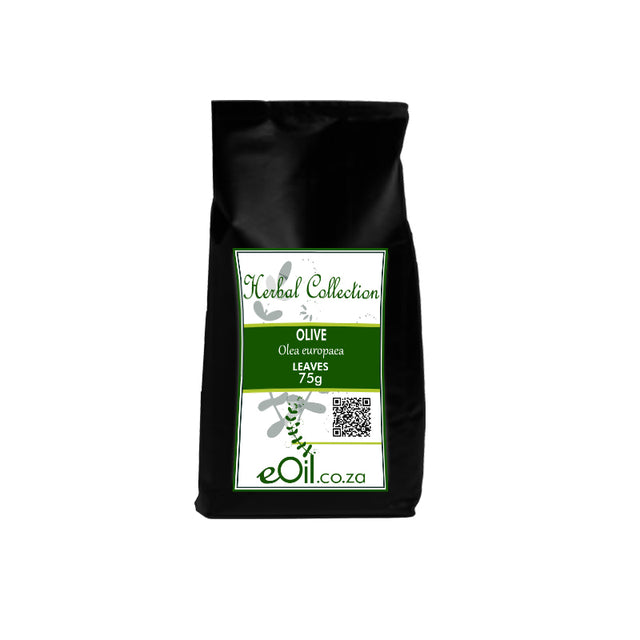Olive Leaf Cut Dried - Herbal Collection
Olive Leaf Cut Dried - Herbal Collection - 75 GR is backordered and will ship as soon as it is back in stock.
Description
Description
TRADITIONALLY USED FOR
May help with
- reduces cardiovascular risk, like atherosclerosis.
- lowers blood pressure.
- helps treats type 2 diabetes.
- supports weight loss.
- eliminates free radicals.
- boosts immunity.
- fights herpes.
- reduces inflammation.
INFORMATION
Source : http://www.wikiphyto.org/wiki/Olive
Reference on http://www.wikiphyto.org
Translation in English by Google Translate (go to the page of the source linked | on Chrome cellphones go on the 3 dots on the top right and select translate in your preferred language | on laptop right click your mouse and select option translate when hoovering on the page
plant name
Olivier, olive (English)
International Latin denomination
botanical family
Oleaceae
Description and habitat
- Tree often cultivated in the Mediterranean regions, about 10 meters in height, with a gray trunk of tortuous appearance, cracked, numerous branches bearing evergreen, lanceolate, greyish-green, leathery leaves, with a revolute edge
- Species native to Syria and naturalized in southern France, Corsica and Algeria. It requires full light, looking for dry soils, with warm exposures; vigorous tree that can live for a very long time, with very compact and very homogeneous wood. The wild olive tree called Oleaster was spontaneous throughout the Mediterranean basin. The limits of the olive tree are above all the cold of the North or the excessive drought (Egypt) but its possible areas can be extended to California, South Africa and Australia
History and tradition
- It is believed to have been domesticated in Crete around 3500 BC. JC
- Tree associated with many symbols, the olive branch is a symbol of peace, the crown of olive leaves was placed on the head of the winners of the Olympic Games in Greece
Parts used
- Dried leaves, buds, olive (hard stone drupe)
Dosage forms available
- Leafy twig tincture
- Young growth glycerine macerate
- sheet eps
- Dry extracts
- Fluid extracts
Usual dosages
- Leaves: 30 grams per liter, 1 liter per day of decoction, by discontinuous cures
- Buds MG 1°D, 50 drops three times a day or a teaspoonful in the morning
- EPS : 15 ml (or three teaspoons) to put in a liter of water and drink during the day, 10 days a month; or a teaspoon in the morning
- Dry extract : 400 to 500 mg for one capsule to be taken morning and evening (800 mg to 1 g per day)
Composition
Main components of the plant
Sheet [1] :
- Secoiridoids ( oleuropeoside ( oleuropein ), 11-demethyloleuropeoside , ligustroside , oleuroside , non-heteroside secoiridoid aldehydes ) 6–14% of dry weight, but some cultivars contain even more
- Tetra- and pentacyclic triterpenes ( oleanane , ursane , lupane , taraxerane , taraxastane , euphane , lanostane skeletons ): oleanolic acid , ursolic acid , maslinic acid
- Flavonoids :
- Flavones : luteolin , apigenin glycosides , apigenin-7-glucoside , diosmetin , luteolin-7-glucoside , diosmetin-7-glucoside
- Flavonols : ( rutoside
- Flavan-3-ols : catechin
- Phenolic derivatives : tyrosol and hydroxytyrosol , vanillin , vanillic acid , caffeic acid
- Verbascoside
fruit:
- Fatty oil rich in essential fatty acids (AGE):
- 63-81% oleic acid (omega-9)
- 15% linoleic acid (omega-6)
- Oleocanthal
- Tocopherols or vitamin E: 1.6 mg per tablespoon
- Maslinic acid
Main components of buds or young shoots
Main components of essential oil
Properties
Plant properties
- Leaf :
- Hypotensive (modest action) [3] , but a study shows identical efficacy of 500 mg of standardized extract of olive leaves twice a day to that of 12.5 to 25 mg of Captopril twice a day [4] , average decrease of 5 to 13 mm Hg [5]
- Secoiridoids ( oleuropein , ligustroside , excelcioside , oleoside 11-methyl ester , oleoside ) are angiotensin-converting enzyme (ACE) inhibitors [6] , hypotensives, and lipid-lowering [7]
- Moderate beta-blocker and calcium-blocker effect [8] , [9]
- Coronaro-dilator, increases coronary flow, cardiac protector by combining antioxidant, antihypertensive, hypoglycemic, hypocholesterolemic [10] , antiatherogenic [11] , protector of myocardial function by an anti-inflammatory, antiatherosclerotic, anti-ischemic, hypolipidemic effect [12] , protection of myocardial cells (cardiomyocytes) [13] , protector of vascular function [14]
- Bradycardic antiarrhythmic ( oleanolic acid ) by beta-adrenergic antagonist effect, negative chronotropic and positive inotropic effects [15]
- Cardioprotective, the ethanolic extract of olive leaves, which contains oleuropein , hydroxytyrosol , verbascoside , luteolin and quercetin exerts a protective effect on cardiomyocyte viability greater than that of each of these phenolic compounds [16]
- Inhibition of platelet aggregation [17]
- Spasmolytic
- Antioxidant [18] , [19]
- Hypocholesterolemic, hypotriglyceridemic and anti-diabetic (especially the oleaster variety ) [20] , hypoglycemic in rats [21]
- Antidiabetic by inhibition of alpha-amylase and alpha-glucosidase ( luteolin and its derivatives luteolin-7-O-β-glucoside and luteolin-4′-O-β-glucoside ) [22] , hypoglycemic by oleuropeoside at a dose of 16 mg/kg, resulting from two mechanisms: potentiation of glucose-induced insulin release and increased peripheral glucose absorption [23] , antidiabetic properties in rats (leaf extract with doses of 0.1, 0.25, 0.5 g/kg of body weight for 14 days) higher than those of glibenclamide (600 microg/kg) [24] , oleuropein and oleanolic acidare involved in the anti-diabetic effect of olive leaves [25]
- Improves insulin sensitivity and lowers the risk of developing metabolic syndrome [26]
- Antibacterial and antifungal [27] by phenolic derivatives
- Nephroprotective [28]
- Thyroid stimulant (?) pituitary-independent activity [29]
- Hypotensive (modest action) [3] , but a study shows identical efficacy of 500 mg of standardized extract of olive leaves twice a day to that of 12.5 to 25 mg of Captopril twice a day [4] , average decrease of 5 to 13 mm Hg [5]
- Olive oil :
Bud properties
- Anti-hypertensive
- Mildly antidiabetic
- Vascular action
Properties of essential oil
Directions
Indications of the whole plant (phytotherapy)
- Arterial hypertension by moderate beta-blocker and calcium-blocker effect [8] , [9] , and an action of inhibition of the angiotensin converting enzyme (IEC) [6]
- Efficacy at 400 mg per day of dry extract according to the EMA [33]
- Venous circulatory disorders
- Mild diabetes ( oleuropein , hydroxytyrosol ) [34] , reduction of diabetes complications ( oleuropein ) [35]
Indications of the bud (gemmotherapy)
- Metabolic syndrome
- Non-thrombotic cerebral atherosclerosis, diabetic arteritis, gangrene [36]
- With Prunus amygdalus :
- Phobic neurosis: agarophobia, claustrophobia etc.
- Obsessive compulsive neurosis
- With Ficus carica :
- Facial neuralgia
Specific indications of essential oil (aromatherapy)
Known or suspected mode of action
- Antihypertensive by beta-blocker effect, calcium antagonist [8] , [9] , and inhibition of angiotensin converting enzyme (IEC) [6]
Usual formulations
- Olive leaves Olea europea : 30 grams for one liter of water; boil for 10 minutes over low heat; infuse one hour. Drink during the day, 5 days a week, three weeks a month, for three months
- Dry extract : 400 to 500 mg for one capsule to be taken morning and evening (800 mg to 1 g per day) (high blood pressure)
- 400 mg of dry extract per day according to the EMA
Regulations
- French Pharmacopoeia list A (sheet)
Possible side effects and precautions for use
- No adverse effects or interactions listed
- Very moderate pharmacokinetic interactions of oleuropein with cytochromes P450 (weak inhibition of CYP1A2) [37]
- Weak inhibition of maslinic acid on CYP3A4 activity, low risk of drug interaction [38]
- Potential Pharmacodynamic Interactions with Antidiabetic and Antihypertensive Drugs
Bibliographic references
- Aller↑ Aouidi, 2012., Study and valorization of Olea europeae olive leaves in the food industry. Doctoral thesis in biological engineering. University of Carthage (Tunisia). p 213.
- Aller↑ Stiti N, Hartmann MA. Nonsterol Triterpenoids as Major Constituents of Olea europaea. J Lipids. 2012;2012:476595. doi: 10.1155/2012/476595. PMID 22523691
- Aller↑ Khayyal MT, el-Ghazaly MA, Abdallah DM, Nassar NN, Okpanyi SN, Kreuter MH. Blood pressure lowering effect of an olive leaf extract (Olea europaea) in L-NAME induced hypertension in rats. Arzneimittelforschung. 2002;52(11):797-802. PMID 12489249
- Aller↑ Susalit E, Agus N, Effendi I, Tjandrawinata RR, Nofiarny D, Perrinjaquet-Moccetti T, Verbruggen M. Olive (Olea europaea) leaf extract effective in patients with stage-1 hypertension: comparison with Captopril. Phytomedicine. 2011 Feb 15;18(4):251-8. doi: 10.1016/j.phymed.2010.08.016. PMID 21036583
- Aller↑ Perrinjaquet-Moccetti T, Busjahn A, Schmidlin C, Schmidt A, Bradl B, Aydogan C. Food supplementation with an olive (Olea europaea L.) leaf extract reduces blood pressure in borderline hypertensive monozygotic twins. Phytother Res. 2008 Sep;22(9):1239-42. doi: 10.1002/ptr.2455. PMID 18729245
- ↑ Aller à :6.0 6.1 and 6.2 Hansen K, Adsersen A, Christensen SB, Jensen SR, Nyman U, Smitt UW. Isolation of an angiotensin converting enzyme (ACE) inhibitor from Olea europaea and Olea lancea. Phytomedicine. 1996 Mar;2(4):319-25. doi: 10.1016/S0944-7113(96)80076-6. PMID 23194770
- Aller↑ Lockyer S, Rowland I, Spencer JPE, Yaqoob P, Stonehouse W. Impact of phenolic-rich olive leaf extract on blood pressure, plasma lipids and inflammatory markers: a randomized controlled trial. Eur J Nutr. 2017 Jun;56(4):1421-1432. doi: 10.1007/s00394-016-1188-y. PMID 26951205
- ↑ Aller à :8.0 8.1 and 8.2 Scheffler A, Rauwald HW, Kampa B, Mann U, Mohr FW, Dhein S. Olea europaea leaf extract exerts L-type Ca(2+) channel antagonistic effects. J Ethnopharmacol. 2008 Nov 20;120(2):233-40. doi: 10.1016/j.jep.2008.08.018. PMID 18790040
- ↑ Aller à :9.0 9.1 and 9.2 Rauwald HW, Brehm O, Odenthal KP. Screening of nine vasoactive medicinal plants for their possible calcium antagonistic activity. Strategy of selection and isolation for the active principles of Olea europaea and Peucedanum ostruthium. Phytotherapy Research, Volume 8, Issue 3, pages 135–140, May 1994 [1]
- Aller↑ Vogel P, Kasper Machado I, Garavaglia J, Zani VT, de Souza D, Morelo Dal Bosco S. Polyphenols benefits of olive leaf (Olea europaea L) to human health. Nutr Hosp. 2014 Dec 17;31(3):1427-33. doi: 10.3305/nh.2015.31.3.8400. PMID 25726243
- Aller↑ El SN, Karakaya S. Olive tree (Olea europaea) leaves: potential beneficial effects on human health. Nutr Rev. 2009 Nov;67(11):632-8. doi: 10.1111/j.1753-4887.2009.00248.x. PMID 19906250
- Aller↑ Efentakis P, Iliodromitis EK, Mikros E, Papachristodoulou A, Dagres N, Skaltsounis AL, Andreadou I. Effects of the olive tree leaf constitute on myocardial oxidative damage and atherosclerosis. PlantaMed. 2015 Jun;81(8):648-54. doi: 10.1055/s-0035-1546017. PMID 26018920
- Aller↑ El SN, Karakaya S. Olive tree (Olea europaea) leaves: potential beneficial effects on human health. Nutr Rev. 2009 Nov;67(11):632-8. doi: 10.1111/j.1753-4887.2009.00248.x. PMID 19906250
- Aller↑ Lockyer S, Corona G, Yaqoob P, Spencer JP, Rowland I. Secoiridoids delivered as olive leaf extract induce acute improvements in human vascular function and reduction of an inflammatory cytokine: a randomised, double-blind, placebo-controlled, cross-over trial. Br J Nutr. 2015 Jul 14;114(1):75-83. doi: 10.1017/S0007114515001269. PMID 26051429
- Aller↑ Javidanpour, S., Dianat, M., Aliakbari, FR, & Sarkaki, A. (2018). The effects of olive leaf extract and 28 days forced treadmill exercise on electrocardiographic parameters in rats. Journal of research in medical sciences: the official journal of Isfahan University of Medical Sciences, 23, 108. https://doi.org/10.4103/jrms.JRMS_517_18
- Aller↑ Bali EB, Ergin V, Rackova L, Bayraktar O, Küçükboyaci N, Karasu Ç. Olive leaf extracts protect cardiomyocytes against 4-hydroxynonenal-induced toxicity in vitro: comparison with oleuropein, hydroxytyrosol, and quercetin. PlantaMed. 2014 Aug;80(12):984-92. doi: 10.1055/s-0034-1382881. PMID 25098929
- Aller↑ Singh I, Mok M, Christensen AM, Turner AH, Hawley JA. The effects of polyphenols in olive leaves on platelet function. Nutr Metab Cardiovascular Dis. 2008 Feb;18(2):127-32. PMID 17346951
- Aller↑ O Benavente-Garcı́a, J Castillo, J Lorente, A Ortuño, JA Del Rio. Antioxidant activity of phenolics extracted from Olea europaea L. leaves. Food Chemistry, Volume 68, Issue 4, March 2000, Pages 457–462
- Aller↑ Lkrik, A., Souidi, K., & Martin, P. Effect of polyphenols extracted from cakes and leaves of the olive tree (Olea europaea L) on the oxidative stability of olive oil. Full Text
- Aller↑ Bennani-Kabchi N, Fdhil H, Cherrah Y, Kehel L, el Bouayadi F, Amarti A, Saïdi M, Marquié G. Effects of Olea europea var. oleaster leaves in hypercholesterolemic insulin-resistant sand rats. Therapy. 1999 Nov-Dec;54(6):717-23. PMID 10709446
- Aller↑ Trovato A, Forestieri AM, Iauk L, Barbera R, Monforte MT, Galati EM. Hypoglycemic activity of different extracts of Olea europae L. in the rats. Medicinal Plants and Phytotherapy, 1993, vol. 26, no.4, pp. 300-308
- Aller↑ Eddouks Mohamed, Chattopadhyay Debprasad. Phytotherapy in the Management of Diabetes and Hypertension. Bentham Science Publishers, 2012. eISBN: 978-1-60805-014-7
- Aller↑ Gonzalez M, Zarzuelo A, Gamez MJ, Utrilla MP, Jimenez J, Osuna I. Hypoglycemic activity of olive leaf. PlantaMed. 1992 Dec;58(6):513-5. PMID 1484890
- Aller↑ Eidi A, Eidi M, Darzi R. Antidiabetic effect of Olea europaea L. in normal and diabetic rats. Phytother Res. 2009 Mar;23(3):347-50. doi: 10.1002/ptr.2629. PMID 18844257
- Aller↑ Sato H, Genet C, Strehle A, Thomas C, Lobstein A, Wagner A, Mioskowski C, Auwerx J, Saladin R. Anti-hyperglycemic activity of a TGR5 agonist isolated from Olea europaea. Biochem Biophys Res Commun. 2007 Nov 3;362(4):793-8. PMID 17825251
- Aller↑ de Bock M, Derraik JG, Brennan CM, Biggs JB, Morgan PE, Hodgkinson SC, Hofman PL, Cutfield WS. Olive (Olea europaea L.) leaf polyphenols improve insulin sensitivity in middle-aged overweight men: a randomized, placebo-controlled, crossover trial. PLoS One. 2013;8(3):e57622. doi: 10.1371/journal.pone.0057622. PMID 23516412
- Aller↑ Pereira AP, Ferreira IC, Marcelino F, Valentão P, Andrade PB, Seabra R, Estevinho L, Bento A, Pereira JA. Phenolic compounds and antimicrobial activity of olive (Olea europaea L. Cv. Cobrançosa) leaves. Molecules. 2007 May 26;12(5):1153-62. PMID 17873849
- Aller↑ Azab, AE, Albasha, MO, Elsayed, ASI (2017) Prevention of Nephropathy by Some Natural Sources of Antioxidants. Yangtze Medicine, 1, 235-266. https://doi.org/10.4236/ym.2017.14023
- Aller↑ Al-Qarawi AA, Al-Damegh MA, El Mougy SA. Effect of freeze dried extract of Olea europaea on the pituitary-thyroid axis in rats. Phytother Res. 2002 May;16(3):286-7. PMID 12164280
- Aller↑ Beauchamp GK, Keast RS, Morel D, Lin J, Pika J, Han Q, Lee CH, Smith AB, Breslin PA. Phytochemistry: ibuprofen-like activity in extra-virgin olive oil. Nature. 2005 Sep 1;437(7055):45-6. PMID 16136122
- Aller↑ Petroni A, Blasevich M, Salami M, Papini N, Montedoro GF, Galli C. Inhibition of platelet aggregation and eicosanoid production by phenolic components of olive oil. Thromb Res. 1995 Apr 15;78(2):151-60. PMID 7482432
- Aller↑ Saleh NK, Saleh HA. Olive Oil Effectively Mitigates Ovariectomy Induced Osteoporosis In Rats. BMC Complementary and Alternative Medicine 2011, 11:10 (4 February 2011) [2]
- Aller↑ Assessment report on Olea europaea L., folium Final. EMA/HMPC/359236/2016, Committee on Herbal Medicinal Products (HMPC), 31 January 2017 pdf
- Aller↑ Jemai H, El Feki A, Sayadi S. Antidiabetic and antioxidant effects of hydroxytyrosol and oleuropein from olive leaves in alloxan-diabetic rats. J Agric Food Chem. 2009 Oct 14;57(19):8798-804. doi: 10.1021/jf901280r. PMID 19725535
- Aller↑ Al-Azzawie HF, Alhamdani MS. Hypoglycemic and antioxidant effect of oleuropein in alloxan-diabetic rabbits. Life Sci. 2006 Feb 16;78(12):1371-7. PMID 16236331
- Aller↑ Henry Pol. Gemmotherapy, therapy with plant embryonic extracts. Author's edition. Brussels, 1982
- Aller↑ I Stupans, M Murray, A Kirlich, KL Tuck, PJ Hayball. Inactivation of cytochrome P450 by the food-derived complex phenol oleuropein. Food and Chemical Toxicology, Volume 39, Issue 11, 2001, Pages 1119-1124, https://doi.org/10.1016/S0278-6915(01)00060-6 .
- Aller↑ Min Sun, Yu Tang, Tonggui Ding, Mingyao Liu, Xin Wang. Investigation of cytochrome P450 inhibitory properties of maslinic acid, a bioactive compound from Olea europaea L., and its structure–activity relationship. Phytomedicine, Volume 22, Issue 1, 2015, Pages 56-65, https://doi.org/10.1016/j.phymed.2014.10.003 .
- Bruneton J. Pharmacognosy, Phytochemistry, Medicinal Plants. Ed. Tec and Doc. 1997. p. 487
- El SN, Karakaya S. Olive tree (Olea europaea) leaves: potential beneficial effects on human health. Nutr Rev. 2009 Nov;67(11):632-8. doi: 10.1111/j.1753-4887.2009.00248.x. PMID 19906250
- Rovellini P, Cortesi N, Fedeli E. Analysis of flavonoids from Olea Europaea by HPLC-UV and HPLC-electrospray-MS. Rivista Italiana delle Sostanze Grasse, 1997, vol. 74, no.7, pp. 273-279
- Ficarra P, Ficarra R, de Pasquale A, Monforte MT, Calabrò ML. HPLC analysis of oleuropein and some flavonoids in leaf and bud of Olea europaea L. Farmaco. 1991 Jun;46(6):803-15. PMID 1772565
- Fernando J. Reyes, Josep J. Centelles, José A. Lupiáñez, Marta Cascante. (2α,3β)-2,3-Dihydroxyolean-12-en-28-oic acid, a new natural triterpene from Olea europea, induces caspase dependent apoptosis selectively in colon adenocarcinoma cells. FEBS letters, Volume 580, Issue 27, 27 November 2006, Pages 6302–6310
CAUTION
Store in a cool, dry place, away from light. Keep tightly closed, away from the reach of Children and pets.
Do not exceed the daily dose.
This product is not intended to prevent or cure any form of illness or disease.
If you are pregnant or nursing ; If you have a medical condition or are in the course of medical treatment ; If you are programmed for theater/operation in the near future, please consult your healthcare practitioner before using this product.
This product cannot replace a varied and balanced diet and a healthy lifestyle.
This product has not been evaluated by the SAHPRA for its quality, safety or intended use.
For More Information please check our General Safety Herbal products Page

Olive Leaf Cut Dried - Herbal Collection - 75 GR is backordered and will ship as soon as it is back in stock.





